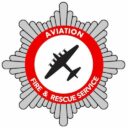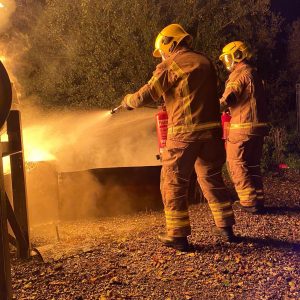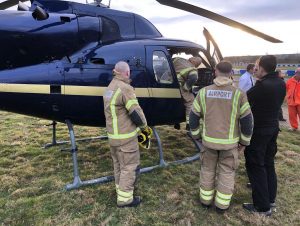
Aviation FRS
A volunteer team of Trained Firefighters, providing Airfield Rescue & Firefighting Services to charities accross the south of England.
In an emergency, always call

Page Coming Soon
Aviation fire and rescue are a 100% volunteer crew, but this doesn’t preclude us from being a fully qualified fire crew.

AFRS train to national standards, with all our operational crew members being trained and assessed to the standard of a ‘Low Category Aerodrome Firefighter’, or possessing existing experience from local authority fire and rescue services.
Through meticulous training, AFRS Crew members are capable of dealing with a wide range of incidents including, but not limited to:
 The crew are well versed in the proper deployment of equipment and positioning of vehicles to ensure the proper management of incidents, with our senior crew members attending national training centres in regard to incident command.
The crew are well versed in the proper deployment of equipment and positioning of vehicles to ensure the proper management of incidents, with our senior crew members attending national training centres in regard to incident command.
Crews are well versed in a variety of fire-fighting mediums, including lighter options such as fire extinguishers and blankets.
The clue is likely in the name, but Aviation Fire and Rescue have clear ability, and a great deal of specialism in providing airfield cover for fly-ins or general airstrip operations.
The crew are well versed in a range of firefighting techniques should the worse happen, and the crew adopts an approach that looks to quickly identify and mitigate any risk of fire, spill or injury that may occur while high risk operations are ongoing.
Further more, in the event of worst case scenario. The crew’s wide breadth of skills and ability, such as cutting and extrication techniques coupled with advanced ‘RTACC’ medical response skills mean that the crew can effectively respond to aviation incidents and effectively resolve them whilst protecting life and property.
Given the hazardous nature of the ‘hot zone’, other first response agencies are unlikely to be able to effectively operate in this area, and so AFRS crew of qualified aerodrome firefighters can ensure a critical and efficient response to support the wider response.
The crew have covered a wide variety of aviation operations of differing sizes, and undertake regular training scenarios and familiarisation with various aircraft to ensure the keenest of skills.
Aviation Fire and Rescue are very fortunate in that we are able to operate Breathing Apparatus (BA) teams, and operate a number of Draeger BA sets.
 Clearly, the proper operation of of Breathing Apparatus is quite a specialist skill, and crew members who are trained in the operation of the sets undertake increased, strenuous training in-house before then going onto an an accredited BA course externally to ensure the highest standards.
Clearly, the proper operation of of Breathing Apparatus is quite a specialist skill, and crew members who are trained in the operation of the sets undertake increased, strenuous training in-house before then going onto an an accredited BA course externally to ensure the highest standards.
Our crews will often undertake scenarios on drill nights and training days where BA skills are practiced. Including undertaking searches of buildings whilst blindfolded in order to locate and extricate a wounded casualty. This ensures that our crew is uniform in deployment in a real world incident, and that the BA operators are comfortable and highly competent in the operation of the kit. This also often includes the deployment and proper management of a BA entry board to manage crew entry and exit. This includes emergency deployments.
Any operator is trained on the proper donning and doffing of the set, as well as ensuring that the masks are properly fitted, and that the kits are operating correctly. This includes maintaining that our crew are clean shaven when training or reporting to duty!
Furthermore, regular checks are undertaken of our BA kits before every event and the sets are regularly serviced and maintained to the manufacturer’s guidance and specifications, at our expense. However, given that these sets are providing a potentially vital lifeline to the operator, and is stepping air pressurised to potentially 300 BAR down so it’s suitable for breathing, it’s a reasonable cost to bear!
Aviation Fire and Rescue are well versed in a variety of extrication techniques in aviation or more ‘domestic’ settings.
The crew have access to a range of cutting equipment, ranging from hand saws through to reciprocating saws and a fully serviced and maintained ‘Jaws of Life’.
The crew are able to couple this equipment with a range of rescue techniques in order to effectively remove trapped person(s) from the vehicle or structure. These extrication techniques, coupled with some of our crew’s more advanced trauma care skills means our crew can efficiently respond to, stabilise and extricate injured patients from a variety scenarios. They then have ability to safely package the patient and remove them to waiting medical services, or treat the casualty until medical help arrives.

Our crew carries a range of equipment including spills booms, absorbent pads and tank repair putty allowing for effective and efficient response to a variety of environmental related incidents such as fuel and oil spills.
Furthering to this, we train to be acutely aware of the presence of water courses, and how terrain (such as incline or soakaways) may aggravate a spill or leak incident and then threaten the wider ecosystem and environment.
We can mobilise quickly to prevent environmental issues from worsening, and are able to support other response agencies where applicable.
Aviation Fire and Rescue is capable of performing bankside rescue and is well versed in safe working around water.
 The crew are trained to DEFRA MOD 1 level, and this allows the crew to identify emergencies on or in the water and then formulate a suitable rescue response through the use of throwlines and buoyancy aids.
The crew are trained to DEFRA MOD 1 level, and this allows the crew to identify emergencies on or in the water and then formulate a suitable rescue response through the use of throwlines and buoyancy aids.
The training also allows our crews to understand the risks and differences between still and flowing water, as well as taking into consideration how immersion in water may affect the patient. This can then be factored into medical treatment that can be immediately rendered by our crews.
Our DEFRA MOD 1 training is delivered by Square Knot Training.

A volunteer team of Trained Firefighters, providing Airfield Rescue & Firefighting Services to charities accross the south of England.
In an emergency, always call